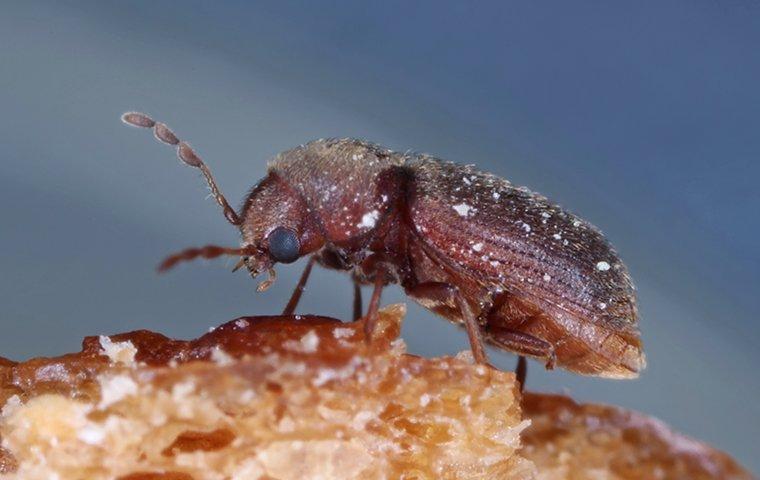Pest infestations are gross enough without even considering that many populations directly contaminate our stored food. Pantry pests can wind up costing you a lot of money, both in replacing the food they ruin and in eliminating the pests themselves. That’s why it’s important to be proactive in preventing pantry pests.
WHAT ARE PANTRY PESTS?
Pantry pests are those that specifically nest in and feed off of dry, stored food items. While all kinds of pests can attack our pantries, like ants and rodents, the term “pantry pest” refers to a more specific group of insects. Here are some of the most common:
- Indian meal moths: Also simply called pantry moths, these are some of the most common and destructive pests in the category. It’s actually their grub-like larvae that eat dry goods like flour and cornmeal, adults simply invade and look for places to lay their eggs.
- Sawtooth beetles: Named after their distinctive maws, these reddish-brown bugs feed off a variety of dry goods.
- Drugstore beetles: These brown, scarab-like beetles are so-called because they give drugstore owners a headache with all the products they can damage or contaminate. They not only eat stored foods, they also chew into stored tobacco packaging.
TIPS FOR INSPECTING THE GOODS
Because pantry pests can threaten homes and businesses alike, it’s important for people to know how to spot signs of contamination. Often, people introduce pantry pests directly into their cupboards and storage areas, by not inspecting their goods closely enough before placing infested boxes in with non-contaminated food. Here’s how you can carefully inspect your goods both before and after purchase, and some tips on how you can prevent pantry pests from spreading:
- Holes: When buying items at the store, and once again before you place them in your pantry, you should thoroughly check the packaging for any holes or tears. These not only indicate that pests might have chewed through, but this can also allow for easy pest access later.
- Eggs: Not only should you look for bite marks and bugs themselves, but you also need to be on the lookout for pest eggs, which are most often white or cream-colored. Their color makes them tough to spot, as they blend in with the kinds of food they often contaminate.
- Containers: In your own home, you should store vulnerable food items in sturdy plastic or metal containers that cannot easily be chewed through by mature pantry pests or their larvae.
- Deep cleaning: Pests don’t have to infest packaging directly if there are enough loose scraps around for them to survive on. You should regularly clean the inside of your storage areas, both for food and other debris that pests might be able to nest in.
TIPS FOR PREVENTING THE BUGS
While it is extremely important to know how to look out for pantry pests and signs of contamination, purchases only account for one aspect of how pest infestations start. It’s also important to generally fortify your home against invasion because mature pantry pests can slip in and lay eggs directly. To protect against infestations, take these steps:
- Window screens: Adult pantry pests usually have developed wings that they use to search for proper nesting grounds. That means they aren’t limited to ground-level access and can easily fly through open windows or land on screens and find a hole or tear to slip through.
- Door sweeps: Doors are another common access point for pests, especially those that can swoop through the air in the second it takes for a door to close. Screens on your doors will limit this, but you should also install door sweeps that make the gap underneath the doorless accessible, too.
- Crack sealing: No crack or hole in your exterior should be treated as too tiny for a pantry pest to squeeze through. Routinely inspect and repair your outer walls.
- Landscaping: Pest infestations typically start in the yard before they invade and find places to nest indoors. You can give pests fewer places to bide their time outside by keeping your lawn trimmed and any vegetation back from your exterior walls.
CONTACT BROADWAY PEST SERVICES FOR MORE ASSISTANCE
Pantry pests pose different problems to property owners depending on what stage of their life cycle they’re in. That also makes them tough to completely defend against or eliminate. Even smart buyers and diligent homeowners can find themselves with a pantry pest problem. That’s why the only true protection comes from pest experts. At Broadway Pest Services, we know how to inspect for and root out every kind of pantry pest that might invade. Even if pantry pests aren’t a problem already, it’s better to get a trained set of eyes checking for them and know for sure rather than be surprised later. Our friendly staff can also provide you with even more tips on how to prevent and defend against invasive insects.
Don’t let pantry pests chew through your grocery budget, contact Broadway Pest Services before a problem can grow out of control.

